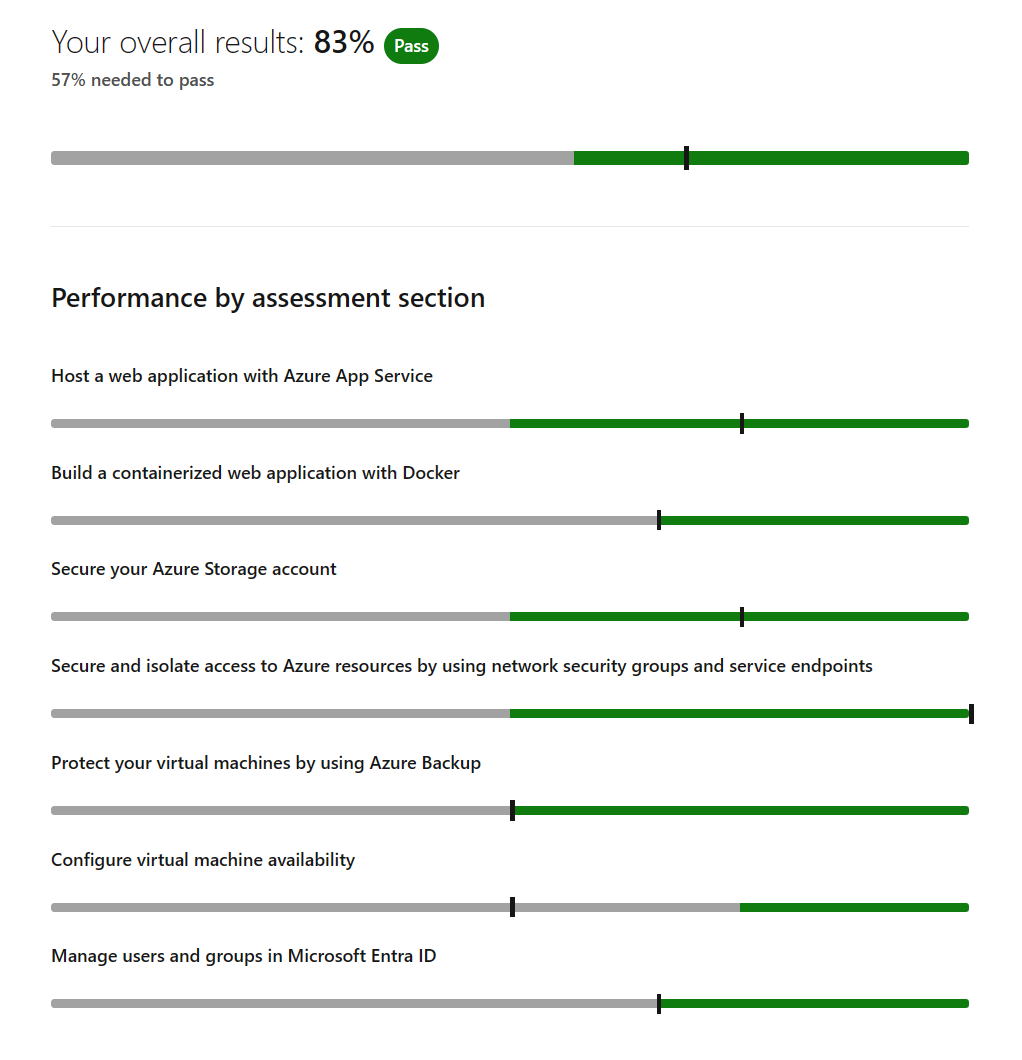Question: You plan to deploy the following Azure web apps:
WebApp1, that uses the .NET 6 runtime stack
WebApp2, that uses the ASP.NET V4.8 runtime stack
WebApp3, that uses the Java 17 runtime stack
WebApp4, that uses the PHP 8.0 runtime stack
You need to create the app service plans for the web apps.
What is the minimum number of app service plans that should be created?
Select only one answer.
Answer: 1
Question: You have an Azure web service named Contoso2022 that runs in the Standard App Service plan. Contoso2022 has five deployment slots in use.
A user named User1 has the Contributor role for Contoso2022.
You need to ensure that User1 can create additional deployment slots to Contoso2022.
What should you do?
Select only one answer.
Answer: Scale up the Contoso2022 App Service plan.
Question: You have an Azure web app named WebApp1.
You discover that backup options are unavailable for WebApp1.
You need to back up WebApp1.
What should you do first?
Select only one answer.
Answer: Scale up the app service plan.
Question: You have Azure web app named WebApp1.
You need to integrate GitHub as a source code repository for WebApp1.
What should you use?
Select only one answer.
Answer: Deployment Center
Question: You plan to create an Azure container instance named container1 that will use a Docker image named Image1.
You need to ensure that container1 has persistent storage.
Which Azure resources should you deploy for the persistent storage?
Select only one answer.
Answer: Azure Storage account and a file share
Question: You have an Azure container registry that stores an image named Image1 and a Windows Server 2022 Azure virtual machine named VM1.
You need to ensure that you can run Image1 in VM1.
What should you install in VM1?
Select only one answer.
Answer: Docker
Question: You have Azure subscription that includes virtual network with following subnets:
Subnet1, which has connected virtual machine
Subnet2, which has connected web app
Subnet3, which has deployed container instance
You plan to deploy container instance named container1.
To which subnets can you deploy container1?
Select only one answer.
Answer: Subnet1, Subnet2 and Subnet3
Question: You have an Azure Storage account named storage1.
You create the following encryption scopes for storage1:
Scope1 that has an encryption type of Microsoft-managed keys
Scope2 that has an encryption type of Customer-managed keys
Which storage services can be used with Scope2?
Select only one answer.
Answer: blob only
Question: You have an Azure subscription that contains the following storage accounts:
storage1, configured as StorageV2 kind
storage2, configured as BlobStorage kind
storage3, configured as FileStorage kind
Which storage account or storage accounts can you use Lifecycle management?
Select only one answer.
Answer: storage1 and storage2 only
Question: You have an Azure Storage account named storage1 that is configured to use the Hot access tier.
Storage1 has a container named container1 and the lifecycle management rule with following settings:
Move blob to cool storage: Selected
Days after last modification: 3
Move blob to archive storage: Selected
Days after last modification: 5
On December 1, you create a file named File1 in container1.
On December 10, you rehydrate File1 and move the file to the Hot access tier.
When will File1 be moved to archive storage?
Select only one answer.
Answer: on December 15
Question: You have an Azure storage account that contains a blob container named container1.
You need to configure access to container1.
Which authorization types can you use?
Select only one answer.
Answer: Microsoft Entra ID, storage key or shared access signature only
Question: You have an Azure virtual network named VNET1 that is connected to a network security group (NSG) named NSG1. NSG1 has the following inbound security rules:
Rule1 has a priority of 100 and allows port 3389 on TCP protocol from any source and to any destination
Rule2 has a priority of 200 and allows ports 80 and 8080 on UDP protocol from any source and to any destination
Rule3 has a priority of 300 and denies ports 1-2000 on TCP protocol from any source and to any destination
Rule4 has a priority of 400 and allows ports 50-500 on TCP protocol from VirtualNetwork source and to any destination
Rule5 has a priority of 500 and allows ports 80 and 443 on TCP protocol from any source and to any destination
You need to allow http and https connections from the internet to VNET1.
What should you change for NSG1?
Select only one answer.
Answer: Priority for Rule5 to 250
Question: You have an Azure subscription that includes following resources:
VNet1, a virtual network
Subnet1, a subnet in VNet1
VM1, a virtual machine
NIC1, a network interface of VM1
LB1, a load balancer
You create a network security group named NSG1.
To which two Azure resources can you associate NSG1?
Select all answers that apply.
Answer: NIC1 and Subnet1
Question: You have an Azure virtual network named VNET1 that has an IP address space of 192.168.0.0/16 and the following subnets:
Subnet1- has an IP address range of 192.168.1.0/24 and is connected to 15 VMs
Subnet2- has an IP address range of 192.168.2.0/24 and does NOT have any VMs connected
You need to ensure that you can deploy Azure Firewall to VNET1.
What should you do?
Select only one answer.
Answer: Add a new subnet to VNET1.
Question: You have an Azure subscription that includes the following resources:
VNet1, a virtual network
Subnet1, a subnet in VNet1
WebApp1, a web app application service
NSG1, a network security group
You create an application security group named ASG1.
Which resource can use ASG1?
Select only one answer.
Answer:NSG1
Question: You have an Azure subscription that contains an Azure disk named Disk1.
You plan to use an Azure Backup to backup Disk1.
What should you deploy first?
Select only one answer.
Answer:a Recovery Services vault
Question: You have a Recovery Services vault named Recovery1 that includes a backup policy named Policy1.
You back up several Azure virtual machines to Recovery1 by using Policy1.
You need to view the Azure Backup reports.
What should you do first?
Select only one answer.
Answer:Create an Azure Log Analytics workspace.
Question: You have the following Azure resources:
a virtual machine named VM1
a Recovery Services vault named Vault1
On January 1, you configure backups for VM1 by using the following backup policy:
Frequency: Daily
Time: 23:00
Timezone: (UTC) Coordinated Universal Time
Retain instant recovery snapshot(s) for: 2 Day(s)
Retention of daily backup point: 7 Day(s)
Azure Backup Resource Group: Backup1RG
How many restore point collections recovery points will be stored in Backup1RG on January 10?
Select only one answer.
Answer:9
Question: You have an Azure subscription that includes a virtual machine named VM1.
You need to protect VM1 by using Azure Backup.
Which Azure resource should you create first?
Select only one answer.
Answer: a recovery services vault
Question: You have an Azure subscription.
You plan to use fault domains.
From which Azure resource can you configure the fault domains?
Select only one answer.
Answer: Availability set
Question: You have an Azure subscription that contains the following resources:
A resource group named RG1 in the West US region
A resource group named RG2 in the Central US region
A virtual network named VNet1 that is deployed to the West US region in RG1
A virtual network named VNet2 that is deployed to the Central US region in RG1
A virtual network named VNet3 that is deployed to the West US region in RG2
You need to deploy a virtual machine named VM1 to RG1 in the West US region.
To which virtual network or virtual networks can you connect VM1?
Select only one answer.
Answer:VNet1 only
Question: Your company has an Azure subscription.
You plan to create a virtual machine scale set named VMSS1 that has the following settings:
Resource group name: RG1
Region: West US
Orchestration mode: Uniform
Security type: Standard
OS disk type: SSD standard
Key management: Platform-managed key
You need to add custom virtual machines to VMSS1.
What setting should you modify?
Select only one answer.
Answer:Orchestration mode
Question: You have an Azure virtual machine named VM1.
VM1 contains the following:
a File named File1 that is stored on volume C:\
a File named File2 that is stored on volume D:\
an App named App1 that is in a running state
a user named User1 that is connected to VM1
You plan to resize VM1.
What is preserved after the resize?
Select only one answer.
Answer:File1, File2, the state of App1 and the connection of User1
Question: Your company has multiple departments and one Azure subscription. The user accounts for all employees are in the same Microsoft Entra tenant.
You need to delegate permissions for the users in a single department only.
What should you use to organize the user accounts?
Select only one answer.
Answer: administrative unit
Question: You have an Azure subscription that contains a user named User1, a resource group named RG1, and a virtual machine named VM1.
You enable a system-assigned managed identity for VM1.
To which identities can you assign the Reports Reader role?
Select only one answer.
Answer:User1 and VM1 only
Question: You have a Microsoft Entra tenant.
You create a user named Admin1.
You need to ensure that Admin1 can perform following tasks:
Assign licenses to Microsoft Entra groups
Reset passwords of Microsoft Entra users
What Microsoft Entra role should you add to Admin1?
Answer: License Administrator
If you would like to support me in providing this content, I would be grateful!
Summary








Tesekkurler cok isime yaradi